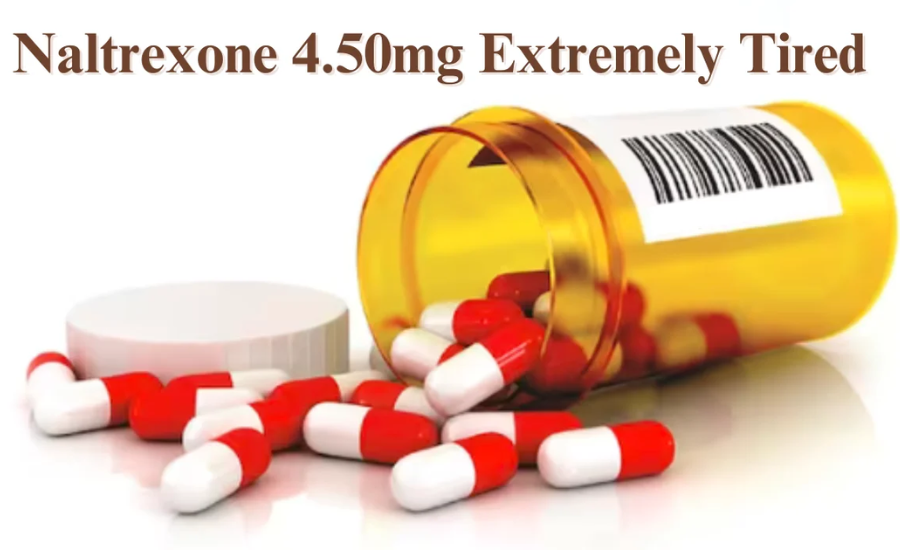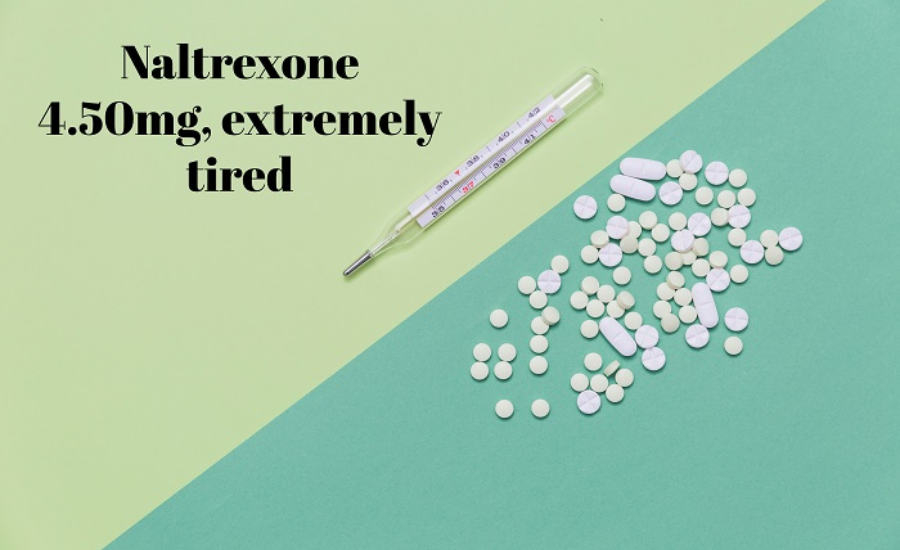Low-dose naltrexone (LDN) has increasingly become a favored treatment option for managing chronic pain and autoimmune conditions due to its potential benefits. Despite its positive effects, a notable side effect that many patients experience is persistent fatigue. If you or someone you know has been grappling with significant tiredness while using LDN, it’s important to recognize that this issue is more common than one might expect. This article delves into the reasons behind this fatigue, explores the potential causes, and offers practical tips for managing this prevalent concern effectively.
What Is Naltrexone 4.50mg?

Low-dose naltrexone (LDN) involves administering naltrexone at significantly lower doses compared to the standard doses used for treating opioid addiction. Originally developed to block the effects of opioids and aid in overcoming addiction, naltrexone has demonstrated promising off-label uses for a range of medical conditions when used in low doses.
In low-dose therapy, typically ranging from 1.5 mg to 4.5 mg, naltrexone has shown potential therapeutic benefits beyond its primary application in addiction treatment. This low-dose approach capitalizes on naltrexone’s unique effects on the body’s endorphin system. By modulating the endorphin system, LDN is believed to offer relief for conditions that are often difficult to manage with conventional therapies.
Common Side Effects Of Low-Dose Naltrexone
1. Insomnia And Sleep Disruptions
One of the most frequently reported side effects of LDN is difficulty with sleep. Patients may experience insomnia or disturbances in their sleep patterns, leading to diminished overall restfulness. This issue is thought to stem from LDN’s effects on the body’s endorphin levels and its interaction with sleep-regulating systems. To address sleep-related issues, patients may need to adjust their dosage timing or explore strategies to improve sleep hygiene.
2. Gastrointestinal Disturbances
LDN can lead to a variety of gastrointestinal symptoms, including nausea, constipation, and abdominal discomfort. These digestive issues can vary in severity and can be bothersome for some patients. Managing gastrointestinal side effects may involve dietary modifications, such as increasing fiber intake or staying hydrated, and consulting with a healthcare provider for additional recommendations.
3. Headaches
Headaches are another common side effect associated with LDN use. The frequency and intensity of headaches can vary from person to person. These headaches might be linked to changes in neurotransmitter levels or other physiological responses triggered by the medication. If headaches persist or become severe, it is advisable to discuss them with a healthcare provider who can offer guidance on potential adjustments to the treatment regimen.
4. Fatigue And Lethargy
Many patients taking LDN report experiencing unusual fatigue or lethargy. This sense of tiredness can impact daily activities and overall quality of life. The precise mechanism behind this fatigue is not fully understood but may be related to the body’s adaptation to the medication or its effects on energy levels. Patients experiencing significant fatigue should consult with their healthcare provider to explore possible solutions, such as adjusting the dosage or evaluating other factors that might be contributing to their tiredness.
Exploring The Connection Between LDN And Fatigue

Fatigue is a notably challenging side effect experienced by many users of low-dose naltrexone (LDN). To address why this occurs, it’s important to delve into several key factors that contribute to this issue:
Contributing Factors To Fatigue From Low-Dose Naltrexone
1. Pharmacological Effects
LDN exerts its effects by temporarily blocking opioid receptors, which in turn influences the production and regulation of neurotransmitters. This temporary blockade disrupts the natural balance of neurotransmitters, potentially leading to feelings of tiredness and reduced energy. The body’s adjustment to these altered neurotransmitter levels can be a significant factor in fatigue, as it needs time to recalibrate its chemical environment and restore balance.
2. Adjustment Period
When initiating LDN therapy, patients often undergo an adjustment period during which their bodies adapt to the new medication. This initial phase can be marked by fatigue as the body acclimates to LDN. For many, this tiredness is a transient side effect that tends to lessen as the body becomes familiar with the medication. However, the length and intensity of this adjustment period can vary greatly among individuals, influencing how long fatigue persists.
3. Underlying Condition
The chronic pain or autoimmune condition being treated with LDN can itself be a source of fatigue. The stress and symptoms associated with managing a chronic illness, along with the potential side effects of other medications, can contribute to overall tiredness. Additionally, if the underlying condition affects sleep quality or general health, it can further exacerbate feelings of fatigue, making it harder to distinguish between the effects of LDN and the impact of the condition being treated.
4. Dosage Issues
The effectiveness and side effects of LDN can be heavily influenced by dosage. Both excessively high and inadequately low doses can affect how the medication interacts with the body. Finding the right dosage is crucial, as an ill-suited dose can lead to increased fatigue. Adjusting the dosage to find the optimal level often involves a trial-and-error process, and this ongoing adjustment can impact the degree of tiredness experienced.
Managing Fatigue Associated With LDN
Understanding these factors can help both patients and healthcare providers manage fatigue more effectively. Strategies to mitigate this side effect include:
- Monitoring and Adjusting Dosage: Work closely with your healthcare provider to find the most suitable dosage. This may involve adjusting the dose based on your response to the medication and monitoring any side effects.
- Allowing for an Adjustment Period: Recognize that fatigue may be temporary and improve as your body adjusts to LDN. Patience during this initial phase is important.
- Addressing Underlying Conditions: Manage the chronic condition being treated with LDN to minimize its contribution to fatigue. This might involve optimizing other aspects of your treatment regimen or improving overall health and well-being.
- Improving Sleep and Lifestyle: Focus on enhancing sleep quality and adopting a healthy lifestyle, including balanced nutrition and stress management, to help reduce overall fatigue.
By addressing these contributing factors and implementing appropriate strategies, patients can better manage fatigue associated with LDN and enhance their overall treatment experience. Regular communication with healthcare providers is key to making necessary adjustments and optimizing therapeutic outcomes.
Tips For Managing Fatigue From LDN
If you’re experiencing fatigue while on low-dose naltrexone (LDN), several strategies can help manage and alleviate this side effect effectively:
Strategies To Manage Fatigue On Low-Dose Naltrexone
1. Adjust The Dosage
If fatigue is becoming a problem, it’s important to consult with your healthcare provider. They may suggest adjusting your LDN dosage to better suit your individual needs. Fine-tuning the dosage can help minimize side effects and enhance the overall effectiveness of the treatment. Your doctor will work with you to find the optimal dose that balances therapeutic benefits with manageable side effects.
2. Optimize Sleep Quality
Improving sleep quality can have a significant impact on your energy levels throughout the day. Establishing a consistent sleep routine can help regulate your internal clock. Create a serene and comfortable sleeping environment, and avoid stimulants such as caffeine and electronic screens before bedtime. These changes can improve your sleep quality and reduce feelings of daytime tiredness.
3. Monitor Diet And Exercise
A balanced diet and regular physical activity are crucial for maintaining high energy levels. Focus on eating nutrient-dense foods that provide essential vitamins and minerals. Incorporate gentle exercises, such as walking or yoga, which can boost overall vitality without causing excessive fatigue. A healthy diet and regular exercise can help combat feelings of tiredness and support overall well-being.
4. Manage Stress
Chronic stress can contribute to feelings of fatigue. Incorporating stress-reduction techniques into your daily routine can be beneficial. Practices such as mindfulness meditation, deep-breathing exercises, or progressive muscle relaxation can help manage stress levels and enhance energy. Effective stress management can lead to improved health and reduced feelings of exhaustion.
5. Consult Your Healthcare Provider Regularly
Regular consultations with your healthcare provider are essential for managing fatigue while on LDN. Your doctor can monitor your progress, evaluate how well you’re adjusting to the medication, and make necessary adjustments to your treatment plan. Keeping open lines of communication with your provider ensures that any issues are addressed promptly and effectively.
Frequently Asked Questions About Fatigue And Low-Dose Naltrexone (LDN)
Q1. How long does fatigue typically last when starting LDN?
Fatigue is a common side effect when initiating LDN therapy, often experienced during the initial adjustment phase. This period usually lasts a few weeks as the body adapts to the medication. If fatigue persists beyond this timeframe or becomes particularly severe, it is important to consult your healthcare provider for further evaluation.
Q2. Can fatigue from LDN be managed without changing the dosage?
Yes, fatigue caused by LDN can often be managed without altering the dosage. Effective strategies include improving sleep quality, maintaining a balanced diet, engaging in regular physical activity, and employing stress-reduction techniques. These measures can help alleviate fatigue and improve overall well-being.
Q3. What should I do if the fatigue is unbearable?
If fatigue becomes severe or disrupts your daily activities, it is crucial to discuss this with your healthcare provider. They can assess your situation, adjust the dosage if necessary, or explore alternative treatment options to better address the side effect.
Q4. Are there any dietary changes that can help with LDN-induced fatigue?
Dietary modifications can aid in managing LDN-induced fatigue. Consuming foods rich in essential vitamins and minerals, such as iron, magnesium, and B vitamins, can support energy levels. Additionally, staying well-hydrated and reducing intake of caffeine and sugar may contribute to improved energy and vitality.
Q5. How often should I follow up with my healthcare provider while on LDN?
Regular follow-up appointments are important for monitoring your response to LDN. Typically, follow-ups every 4 to 6 weeks are recommended. However, your healthcare provider may suggest a different schedule based on your individual needs and progress with the treatment.
Conclusion
Fatigue is a notable side effect that some individuals may experience when using low-dose naltrexone (LDN) to manage chronic pain and autoimmune conditions. This fatigue can stem from various factors, including the pharmacological effects of the medication, the body’s adjustment period to the new treatment, the underlying conditions themselves, and potential issues with dosage. LDN affects the body’s opioid receptors, which can disrupt natural energy levels, and the initial adjustment period can contribute to tiredness as the body acclimates to the medication. Additionally, chronic pain and autoimmune conditions may exacerbate fatigue, making it essential to consider dosage adjustments, improve sleep hygiene, maintain a balanced diet, and manage stress to alleviate tiredness.
Implementing these strategies can help patients continue benefiting from LDN’s therapeutic effects. However, if fatigue persists or significantly impacts quality of life, seeking guidance from a healthcare provider is crucial. A healthcare provider can tailor the treatment plan to better meet individual needs, ensuring both effective management of the condition and overall well-being. Regular consultations and open communication with your provider are key to managing fatigue and optimizing treatment outcomes.
Keep up with the newest updates and notifications: Pudelek!
